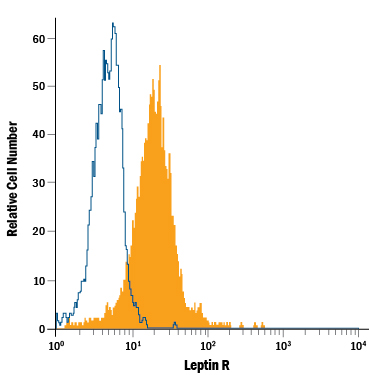Human Leptin R Fluorescein-conjugated Antibody Summary
Phe22-Asp839 (predicted)
Accession # P48357
Applications
Please Note: Optimal dilutions should be determined by each laboratory for each application. General Protocols are available in the Technical Information section on our website.
Scientific Data
 View Larger
View Larger
Detection of Leptin R in Human Blood Monocytes by Flow Cytometry. Human peripheral blood monocytes were stained with Mouse Anti-Human Leptin R Fluorescein-conjugated Monoclonal Antibody (Catalog # FAB867F, filled histogram) or isotype control antibody (Catalog # IC0041F, open histogram). View our protocol for Staining Membrane-associated Proteins.
Reconstitution Calculator
Preparation and Storage
- 12 months from date of receipt, 2 to 8 °C as supplied.
Background: Leptin R
Leptin Receptor (OB-R), also named B219, is a type I cytokine receptor family protein with significant amino acid sequence identity to gp130, G-CSF receptor, and the LIF receptor. Multiple isoforms of human and mouse OB-R, including a long form (OB-RL) with a large cytoplasmic domain capable of signal-transduction, and several receptor isoforms with short cytoplasmic domains (OB-Rs) lacking signal-transducing capabilities, have been identified. The extracellular domains of the short and long forms of OB-R are identical. An OB-R transcript, lacking a transmembrane domain and encoding a potentially soluble form of the receptor has also been described. OB-RL transcripts were reported to be expressed predominantly in regions of the hypothalamus previously thought to be important in body weight regulation. Expression of OB-Rs transcripts have been found in multiple tissues, including the choroid plexus, lung, kidney, and primitive hematopoietic cell populations. OB-R has been shown to be encoded by the mouse diabetes (db) and rat fatty (fa) genes. Rodents homozygous for db or fa mutations have been known to exhibit an obesity phenotype. Human OB-R long form encodes a 1165 amino acid (aa) precursor protein with a 22 aa signal peptide, an 819 aa extracellular domain, a 21 aa transmembrane domain and a 303 aa cytoplasmic domain. The extracellular domain of OB-R contains two hemopoietin receptor domains, a fibronectin type III domain and the WSXWS domain. Recombinant soluble OB-R has been shown to bind Leptin with high affinity and is a potent Leptin antagonist.
Product Datasheets
Citations for Human Leptin R Fluorescein-conjugated Antibody
R&D Systems personnel manually curate a database that contains references using R&D Systems products. The data collected includes not only links to publications in PubMed, but also provides information about sample types, species, and experimental conditions.
2
Citations: Showing 1 - 2
Filter your results:
Filter by:
-
Impaired natural killer cell subset phenotypes in human obesity
Authors: I Bähr, J Jahn, A Zipprich, I Pahlow, J Spielmann, H Kielstein
Immunol. Res., 2018-04-01;0(0):.
Species: Human
Sample Types: Whole Cells
Applications: Flow Cytometry -
Regulatory T cell proliferative potential is impaired in human autoimmune disease.
Authors: Carbone F, De Rosa V, Carrieri P, Montella S, Bruzzese D, Porcellini A, Procaccini C, La Cava A, Matarese G
Nat Med, 2013-12-08;20(1):69-74.
Species: Human
Sample Types: Whole Cells
Applications: Flow Cytometry
FAQs
No product specific FAQs exist for this product, however you may
View all Antibody FAQsReviews for Human Leptin R Fluorescein-conjugated Antibody
There are currently no reviews for this product. Be the first to review Human Leptin R Fluorescein-conjugated Antibody and earn rewards!
Have you used Human Leptin R Fluorescein-conjugated Antibody?
Submit a review and receive an Amazon gift card.
$25/€18/£15/$25CAN/¥75 Yuan/¥2500 Yen for a review with an image
$10/€7/£6/$10 CAD/¥70 Yuan/¥1110 Yen for a review without an image

